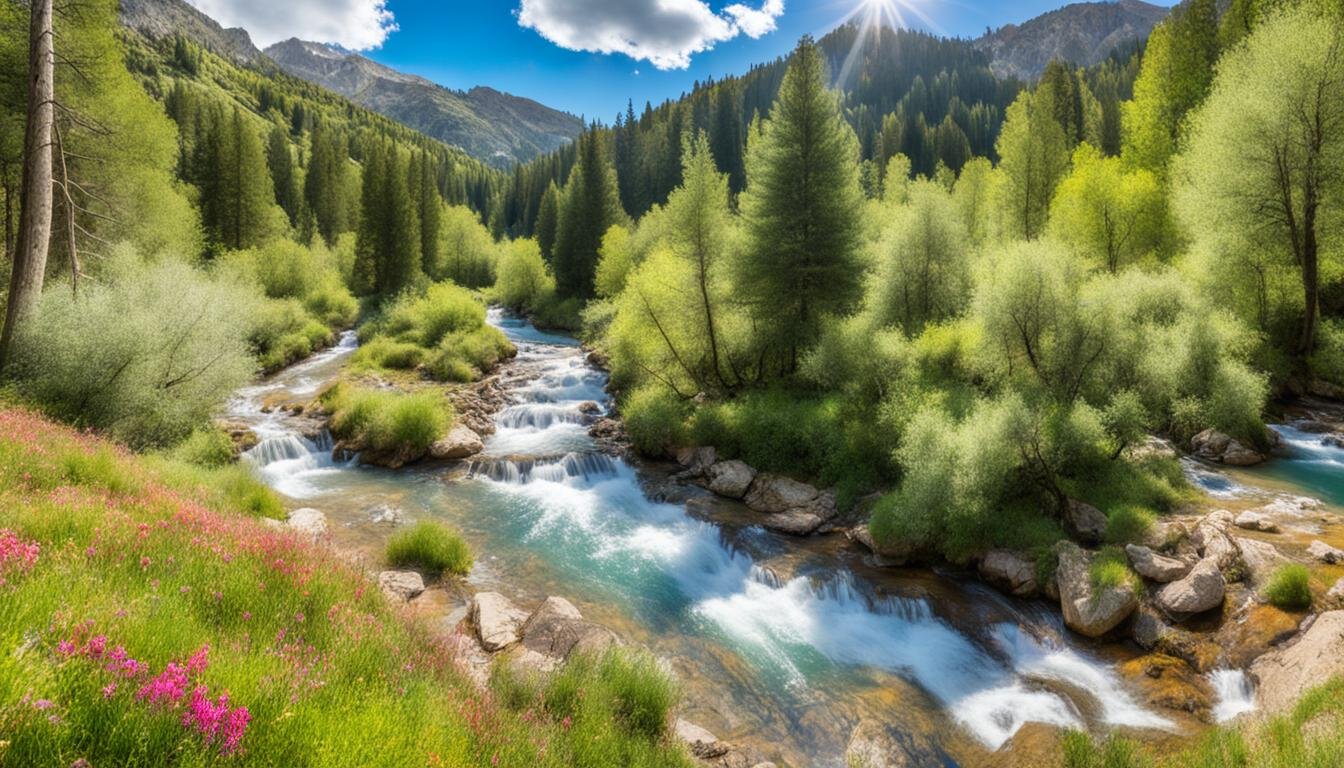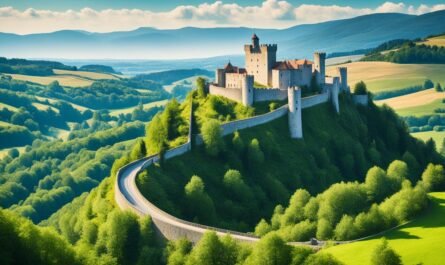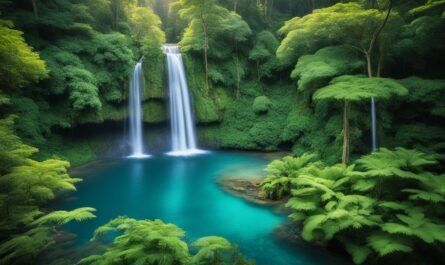Spain is known for its breathtaking beauty and diverse ecosystems, and its national parks and nature reserves are a testament to that. From volcanic landscapes to pristine beaches, these protected areas offer a glimpse into the country’s natural wonders. In this article, we will explore 10 of the most popular and well-reviewed parques nacionales y reservas naturales in Spain.
Key Takeaways:
- Spain is home to a wide range of national parks and nature reserves.
- These protected areas showcase the country’s diverse ecosystems and stunning landscapes.
- From volcanic landscapes to coastal beauty, Spain’s parks offer something for every nature enthusiast.
- These parques nacionales y reservas naturales are popular attractions for both locals and tourists alike.
- Exploring these protected areas allows visitors to experience Spain’s natural treasures and engage in sustainable travel.
Parque Nacional del Teide – Tenerife, Canary Islands
With 34,247 reviews, Parque Nacional del Teide takes the top spot on our list. Located on the island of Tenerife in the Canary Islands, this park is recognized as a UNESCO World Heritage site. It boasts a spectacular volcanic landscape, with Mount Teide being the highest volcano in Spain. Visitors can also enjoy stargazing as the park has been certified as a privileged location for astronomical observation.
When you visit Parque Nacional del Teide, you’ll be greeted by the awe-inspiring sight of the towering Mount Teide, standing at an impressive 3,718 meters above sea level. This dominant volcano is not only the highest peak in Spain but also the third tallest volcano in the world. Its distinctive cone shape and surrounding lunar-like landscape make it a must-visit destination for nature enthusiasts and adventure seekers.
As you explore the park, you’ll be surrounded by a myriad of geological wonders, including lava fields, volcanic cones, and colorful rock formations. The diversity of the landscape is truly remarkable, offering visitors a glimpse into the powerful forces of nature that shaped the Canary Islands millions of years ago.
In addition to its volcanic features, Parque Nacional del Teide is also home to a rich variety of flora and fauna. The park is home to unique plant species that have adapted to the harsh volcanic environment, showcasing the resilience and adaptability of nature. Birdwatchers will delight in spotting the endemic Canarian Chaffinch and Blue Chaffinch, among other avian species.
Parque Nacional del Teide is a testament to the extraordinary natural beauty of the Canary Islands. Its majestic volcano, breathtaking landscapes, and diverse ecosystems make it a truly remarkable destination for outdoor enthusiasts and nature lovers.
Whether you’re hiking through the lava fields, taking in the panoramic views from the cable car, or simply immersing yourself in the serenity of the surroundings, Parque Nacional del Teide offers an unforgettable experience. Don’t miss the opportunity to witness the captivating interplay between volcanic forces and the fragile, yet resilient, ecosystems that thrive in this incredible national park.
Parque Nacional de Timanfaya – Lanzarote, Canary Islands
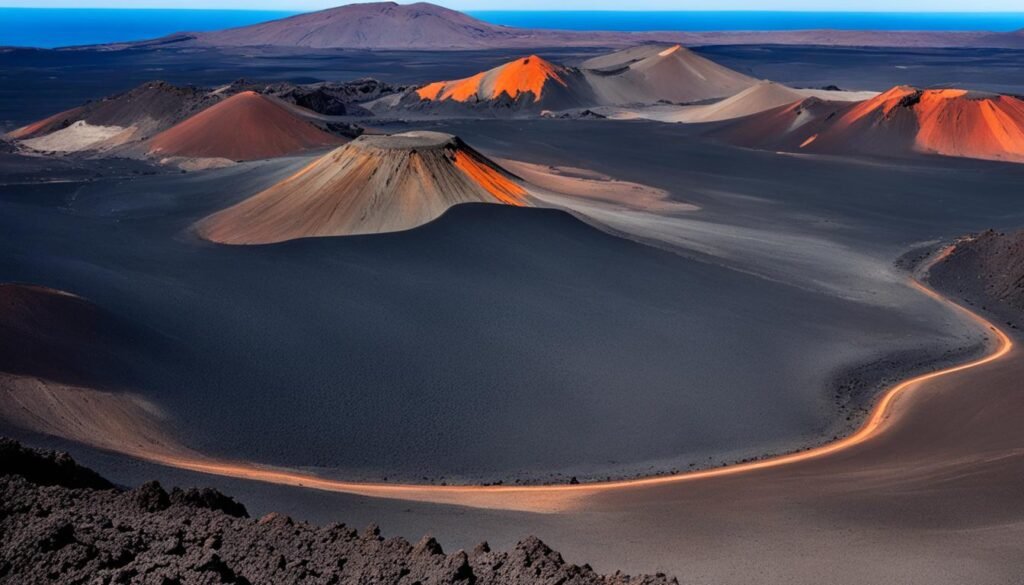
Coming in second place with 28,842 reviews is Parque Nacional de Timanfaya, located in the Canary Islands on the island of Lanzarote. This natural wonder was formed by volcanic eruptions that took place between 1720 and 1736, and again in 1824, leaving behind a mesmerizing volcanic landscape. The park’s unique rock formations and reddish-orange landscapes create an otherworldly atmosphere, reminiscent of the lunar surface.
Visitors to Parque Nacional de Timanfaya can immerse themselves in the extraordinary beauty of this volcanic terrain. The park offers guided tours and experiences that showcase its geological wonders, including the famous Montañas del Fuego (Fire Mountains). Here, visitors can witness demonstrations of the intense heat just below the surface, as geothermal energy causes vegetation to burst into flames and water to erupt in steam.
«Parque Nacional de Timanfaya displays nature’s power and beauty in its purest form. The volcanic landscapes and the barren surroundings make you feel like you’ve stepped foot on another planet.» – Juan Martinez, nature enthusiast and visitor
The park’s strict conservation measures ensure the preservation of its delicate ecosystem. It is a protected area where flora and fauna have adapted to the extreme conditions, creating a unique biodiversity hotspot. Despite its harsh environment, Timanfaya is home to several species of plants and animals that have managed to thrive in this rugged volcanic terrain.
Visitor Information
If you’re planning a visit to Parque Nacional de Timanfaya, here’s some information to help you make the most of your experience:
- Opening Hours: The park is open daily from 9:00 AM to 5:00 PM.
- Tours and Experiences: Guided coach tours and camel rides are available to explore the park’s highlights.
- Visitor Centers: The park has visitor centers where you can learn about the geology, flora, and fauna of the region.
- Dining: Enjoy a unique dining experience at the El Diablo restaurant, where the food is cooked using geothermal heat from the volcano.
Parque Nacional de Timanfaya offers a captivating journey into the heart of a volcanic landscape, where the forces of nature have shaped a truly remarkable environment. Whether it’s witnessing the raw power of geothermal energy or simply marveling at the surreal beauty of the surroundings, a visit to Timanfaya is an awe-inspiring experience you won’t soon forget.
Parc de la Serra de Collserola – Barcelona, Catalonia
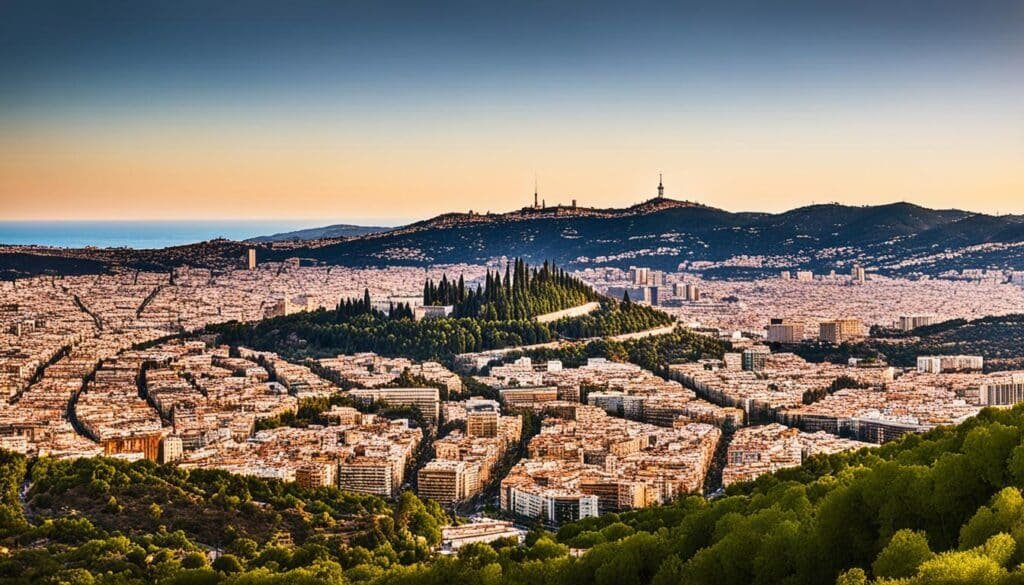
Parc de la Serra de Collserola, located in Barcelona, Catalonia, is a sprawling natural park that encompasses 8,000 hectares of green space. As the largest green area in the metropolitan area of Barcelona, this park provides a sanctuary of nature in the midst of the bustling city.
The parc de la serra de collserola is a haven for outdoor enthusiasts, offering a wide range of activities such as hiking, mountain biking, and bird watching. With its diverse ecosystems, including forests and agricultural areas, the park is home to a rich variety of plant and animal species.
One of the highlights of the parc de la serra de collserola is the presence of cultural and architectural treasures. The park is dotted with medieval castles, such as the Castell de Torre Baró and the Castell de Collserola, which offer a glimpse into the region’s rich history.
The highest point in the park is Tibidabo Hill, which not only provides panoramic views of Barcelona but also features a historic amusement park. Visitors can enjoy rides and attractions that date back to the early 20th century, as well as visit the iconic Collserola Tower designed by renowned architect Norman Foster.
| Key Features of Parc de la Serra de Collserola | Visitors |
|---|---|
| Size | 8,000 hectares |
| Activities | Hiking, mountain biking, bird watching |
| Ecological Importance | Diverse ecosystems, rich biodiversity |
| Cultural Heritage | Medieval castles, Collserola Tower |
| Landmark | Tibidabo Hill |
Whether you’re seeking a peaceful retreat in nature, a chance to explore Barcelona’s history, or simply a breathtaking view of the city, Parc de la Serra de Collserola is a must-visit destination. This natural park seamlessly combines natural beauty, cultural heritage, and recreational activities, making it a beloved spot for both locals and tourists.
Parque Nacional de los Picos de Europa – Asturias, Cantabria, and Castilla y León
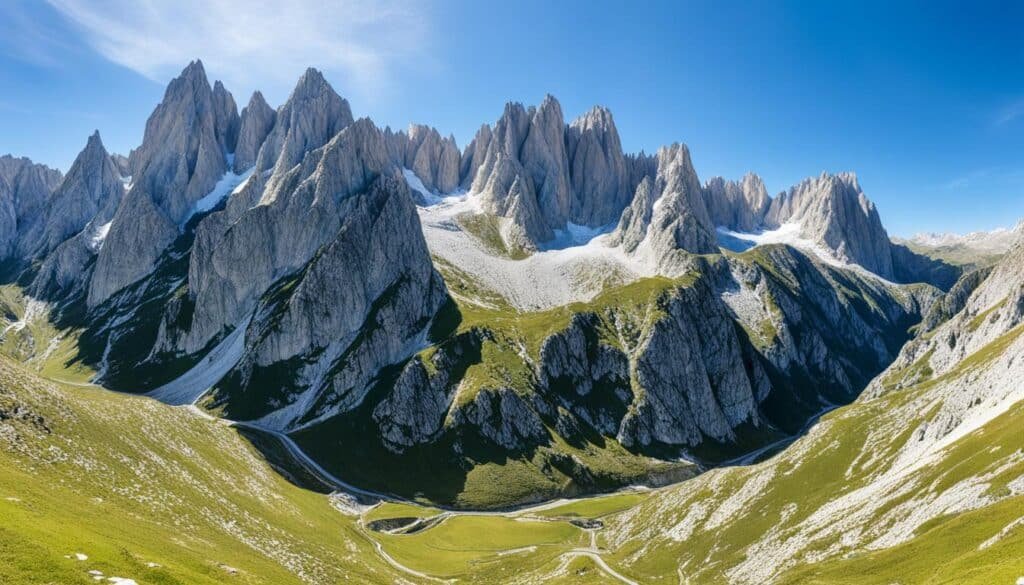
Parque Nacional de los Picos de Europa, located in the Cantabrian Mountains and spanning the regions of Asturias, Cantabria, and Castilla y León, is a breathtaking destination known for its diverse mountainous landscapes. This national park encompasses a wide range of natural wonders, from towering limestone peaks to lush forests of oak and beech trees, picturesque meadows, deep gorges, and crystal-clear lakes.
The iconic Naranjo de Bulnes, also known as Picu Urriellu, is one of the most famous peaks in this park and a favorite among mountaineers. Its striking appearance and challenging ascent make it a must-visit for adventurous travelers.
One of the highlights of Parque Nacional de los Picos de Europa is the Sanctuary of Covadonga, a historic pilgrimage site nestled in the mountains. This picturesque location is not only of religious significance but also offers stunning views of the surrounding landscapes.
«Parque Nacional de los Picos de Europa is a haven for nature enthusiasts and hikers seeking breathtaking mountain scenery.» – Traveler’s Review
Highlights of Parque Nacional de los Picos de Europa
| Highlight | Description |
|---|---|
| Towering Peaks | The park is home to impressive limestone peaks, including the iconic Naranjo de Bulnes. |
| Forests and Meadows | Explore the diverse vegetation of oak and beech forests, as well as picturesque meadows. |
| Gorges | Discover deep gorges that have been carved by rivers over centuries, creating dramatic landscapes. |
| Lakes | Marvel at the crystal-clear lakes nestled amidst the mountains, offering serene beauty. |
| Sanctuary of Covadonga | Visit a historic pilgrimage site with magnificent views and cultural significance. |
Whether you’re an avid hiker, a nature lover, or simply seeking tranquility in a stunning natural setting, Parque Nacional de los Picos de Europa is a destination that should not be missed. Its rugged beauty and diverse landscapes make it a true gem of Spain’s national park system.
Parque Nacional de Sierra Nevada – Granada and Almería, Andalusia
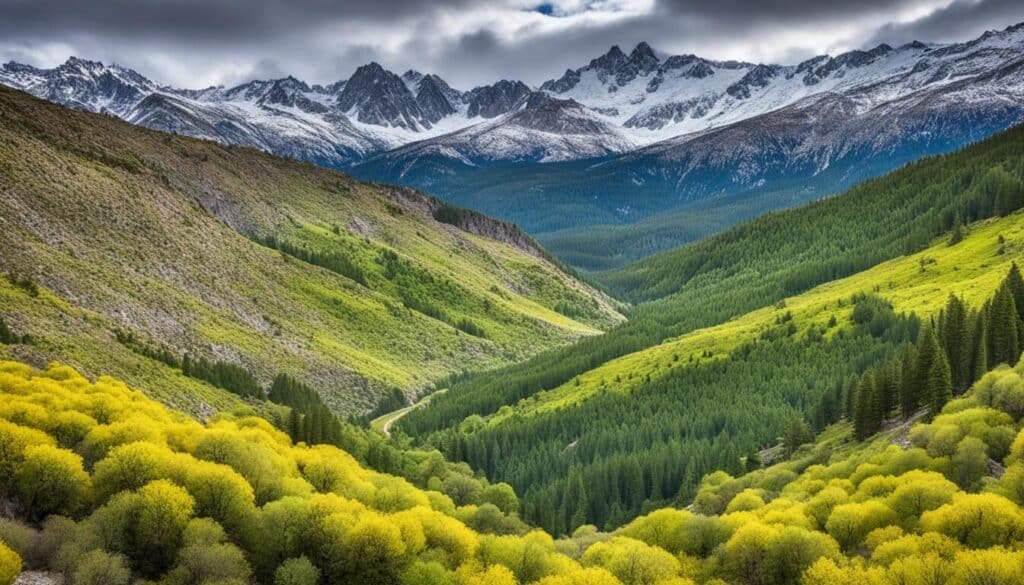
Spanning the provinces of Granada and Almería in Andalusia, the Parque Nacional de Sierra Nevada is the largest national park in Spain. It is a biodiversity hotspot, boasting an exceptional range of flora and fauna. The park’s diverse landscape includes towering peaks, such as Mulhacén, which stands as the highest peak in mainland Spain. It is a haven for outdoor enthusiasts and nature lovers, offering opportunities for hiking, wildlife spotting, and stunning panoramic views.
The Sierra Nevada mountain range, from which the park derives its name, captivates visitors with its majestic beauty. The snow-capped peaks during the winter months create a picturesque scene, while the melting snow feeds into the streams and rivers, sustaining the thriving ecosystems below. The park is also home to glaciers, forests, meadows, and rivers, making it an ideal destination for exploring nature’s wonders.
One of the park’s popular hiking trails is the ascent to Pico Veleta, standing at an impressive elevation of 3,394 meters. This challenging trek rewards hikers with breathtaking vistas of the surrounding landscapes. As visitors traverse the trails, they may encounter a wide array of wildlife, including mountain goats, ibex, eagles, and a variety of rare plant species.
The Parque Nacional de Sierra Nevada serves as a vital ecological sanctuary, encompassing numerous protected areas within its boundaries. It is a testament to Spain’s commitment to environmental preservation and the conservation of its natural heritage. Exploring this pristine wilderness allows visitors to connect with nature, fostering a deeper appreciation for the importance of safeguarding our planet’s biodiversity.
| Key Features of Parque Nacional de Sierra Nevada | Benefits |
|---|---|
| Breathtaking peaks | Offers panoramic views and impressive photo opportunities |
| Glaciers and rivers | Provides freshwater resources and supports diverse ecosystems |
| Forests and meadows | Serves as habitats for a wide range of plant and animal species |
| Hiking trails | Allows visitors to explore the park’s stunning landscapes on foot |
Visiting the Parque Nacional de Sierra Nevada is a remarkable experience, giving tourists the opportunity to immerse themselves in the beauty and tranquility of nature. As you explore the park’s trails, remember to practice responsible tourism by leaving no trace, respecting the flora and fauna, and following the park’s guidelines for a sustainable visit.
Parque Natural de Mondragó – Mallorca, Balearic Islands
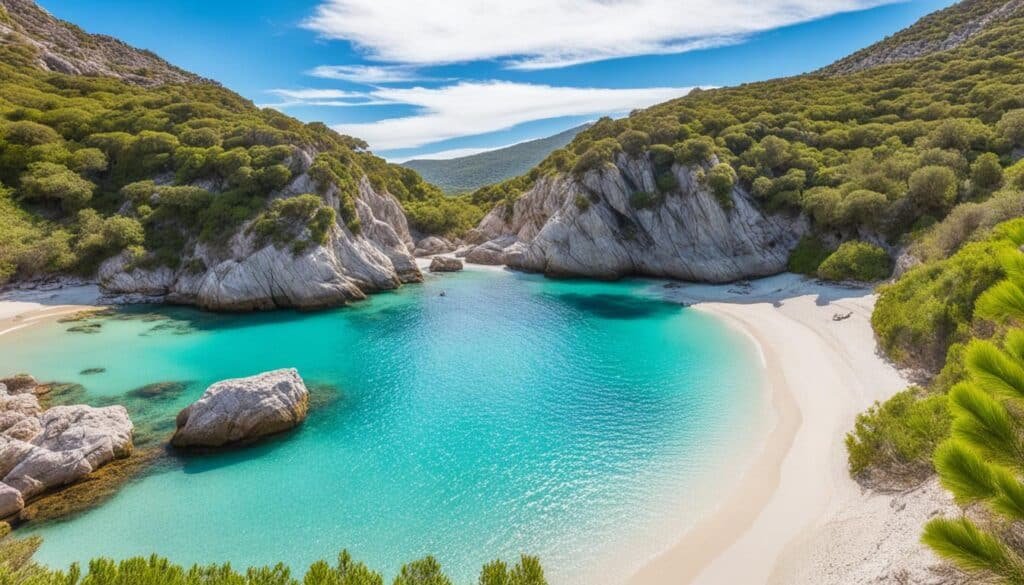
Located in the southern part of Mallorca, Parque Natural de Mondragó is a cherished natural reserve that attracts numerous visitors year-round. This remarkable park boasts diverse ecosystems, creating a paradise for nature enthusiasts and outdoor adventurers alike.
The park offers a range of hiking trails that allow visitors to explore its stunning landscapes and encounter its rich biodiversity. One such trail is the mesmerizing viewpoint trail of Ses Fonts de n’Alis, offering panoramic vistas of the surrounding natural beauty. Another popular hike is the volta a sa Guàrdia d’en Garrot, a picturesque path that takes you through enchanting forests and captivating seaside cliffs.
One of the highlights of Parque Natural de Mondragó is its pristine, untouched beaches. Cala Mondragó and S’Amarador are two of the most famous beaches within the park. With their crystal-clear turquoise waters, fine sand, and idyllic surroundings, these beaches are a true haven for beach lovers seeking a remote and unspoiled coastal experience. These virgin beaches provide an ideal setting for relaxation, swimming, sunbathing, and simply immersing yourself in the natural splendor of the Balearic Islands.
«Parque Natural de Mondragó is a stunning natural reserve in Mallorca, offering diverse ecosystems and beautiful virgin beaches.»
Whether you choose to embark on a hike, soak up the sun on a tranquil beach, or simply revel in the tranquility of nature, Parque Natural de Mondragó promises an unforgettable experience in one of Mallorca’s most captivating natural settings.
| Key Features of Parque Natural de Mondragó | Highlights |
|---|---|
| 1. Diverse ecosystems | Experience the remarkable variety of natural habitats within the park, including forests, cliffs, and wetlands. |
| 2. Hiking trails | Explore the park’s scenic trails, such as the viewpoint trail of Ses Fonts de n’Alis and the volta a sa Guàrdia d’en Garrot. |
| 3. Pristine beaches | Indulge in the beauty of Cala Mondragó and S’Amarador, two picturesque virgin beaches within the park. |
| 4. Unspoiled natural surroundings | Immerse yourself in the unspoiled landscapes of Mallorca’s Balearic Islands and experience true tranquility. |
Parque Nacional de Doñana – Huelva, Andalusia
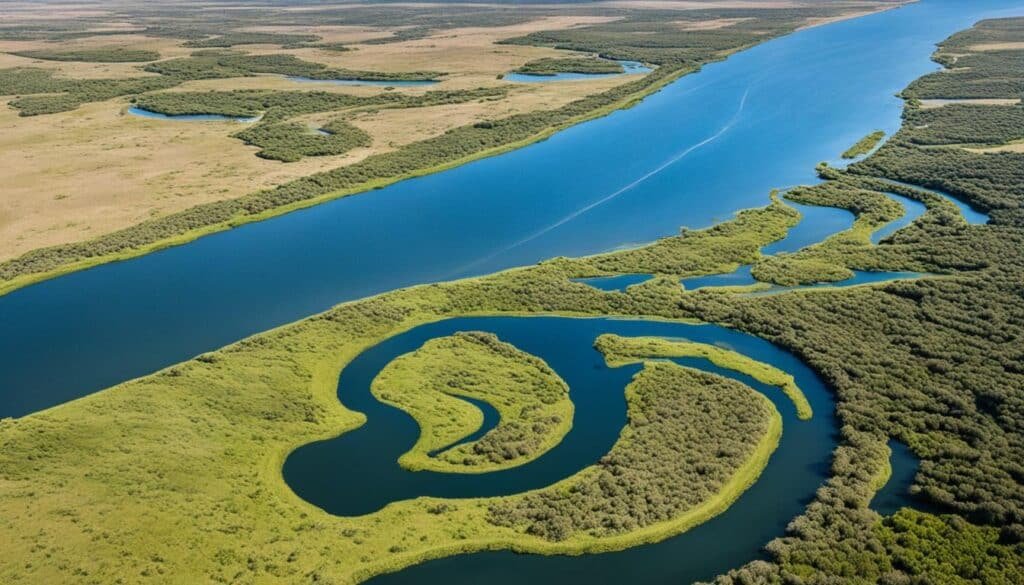
Parque Nacional de Doñana, located in the province of Huelva in Andalusia, is a natural paradise known for its incredible biodiversity and diverse ecosystems. This protected area is a haven for a wide range of species and serves as a vital stopover for migratory birds traveling between Africa and Europe. The park’s unique combination of marshlands, lagoons, mobile dunes, forests, and pristine beaches makes it a biodiversity hotspot and a must-visit destination for nature enthusiasts.
The park covers an area of approximately 543 square kilometers and is named after the village of Doñana, which is located nearby. It is home to emblematic endangered species, such as the Spanish imperial eagle and the Iberian lynx, both of which have found refuge within the park’s boundaries.
One of the park’s most fascinating features is its marshlands, which are considered to be one of the largest and best-preserved wetland areas in Europe. These marshlands provide a crucial habitat for numerous bird species, including flamingos, herons, and spoonbills. Visitors can witness the magnificent sight of thousands of birds taking flight or feeding in the shallow waters, creating a breathtaking spectacle.
| Key Information | |
|---|---|
| Location | Huelva, Andalusia |
| Size | Approximately 543 km² |
| Main Ecosystems | Marshlands, lagoons, mobile dunes, forests, beaches |
| Flora and Fauna | Spanish imperial eagle, Iberian lynx, flamingos, herons, spoonbills, and many more |
| Importance | Vital stopover for migratory birds, biodiversity hotspot |
A visit to Parque Nacional de Doñana offers a unique opportunity to explore and appreciate the beauty of this natural treasure. The park provides various hiking trails and guided tours that allow visitors to immerse themselves in its remarkable landscapes and observe its remarkable wildlife up close. Whether you’re a birdwatcher, a nature photographer, or simply someone who appreciates the wonders of the natural world, Parque Nacional de Doñana is a destination that should not be missed.
Parque Natural de la Sierra Helada – Alicante, Valencian Community
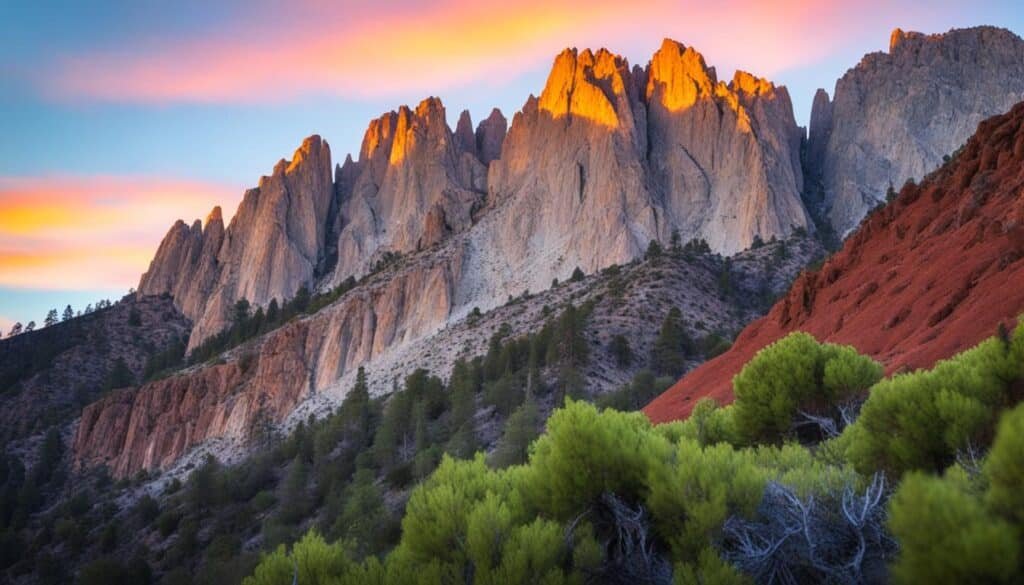
Located in the province of Alicante in the Valencian Community, Parque Natural de la Sierra Helada is a picturesque coastal park that covers an expansive area of over 5,500 hectares. The majority of the park is composed of stunning marine landscapes, making it a unique and diverse natural destination.
This coastal park offers visitors a range of activities to explore its beautiful surroundings. One of the most popular hiking routes is the famous red route, which leads to the iconic l’Albir lighthouse. Along this trail, visitors can enjoy breathtaking views of the turquoise sea and the rugged cliffs that define the coastline.
For those seeking a more challenging adventure, the yellow route presents an exciting opportunity to conquer the highest point of the sierra, Alt del Governador. This trail showcases the park’s diverse terrain and rewards hikers with panoramic vistas of the surrounding landscape.
Beyond its scenic beauty, Parque Natural de la Sierra Helada is also home to a rich diversity of flora and fauna. The park provides a habitat for various bird species, including the Audouin’s gull and the Eleonor falcon. Snorkeling and diving enthusiasts will delight in the underwater wonders of the marine reserve, where they can encounter vibrant marine life and explore the hidden treasures beneath the surface.
Parque Natural de la Sierra Helada is a true coastal paradise, offering visitors a chance to immerse themselves in nature’s beauty and experience the magic of the Valencian coastline.
Whether you choose to embark on a hike, take a boat trip, or simply relax on one of the park’s pristine beaches, Parque Natural de la Sierra Helada is an idyllic destination for nature lovers and adventure seekers alike.
Experience the wonders of Alicante’s coastal park, Parque Natural de la Sierra Helada, and create lasting memories in this captivating natural haven.
Parque Nacional de Ordesa y Monte Perdido – Huesca, Aragón
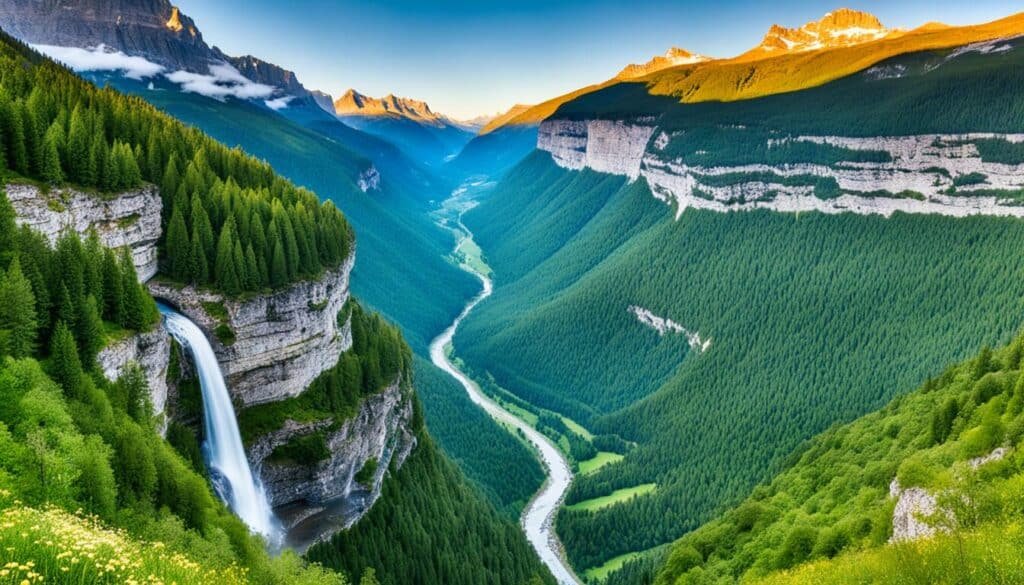
Located in the heart of the Pyrenees in Huesca, Aragón, the Parque Nacional de Ordesa y Monte Perdido is a true gem of natural beauty. This national park is renowned for its scenic landscapes that captivate visitors throughout the year.
The park encompasses four valleys, each offering its unique charm and awe-inspiring vistas. The valleys of Ordesa, Añisclo, Escuaín, and Pineta are a paradise for nature lovers and outdoor enthusiasts.
One of the most iconic features of this park is the majestic Monte Perdido peak. As the third highest peak in the Pyrenees, it stands tall as a testament to the grandeur of nature. Standing at an impressive elevation of 3,355 meters, its snow-capped summit creates a striking contrast against the surrounding valleys.
Visitors to Parque Nacional de Ordesa y Monte Perdido can embark on unforgettable adventures and explore breathtaking wonders. The Tozal del Mallo offers challenging rock climbing opportunities for thrill-seekers, while the Cascada del Estrecho impresses with its magnificent waterfall. The Bosque de las Hayas, a beautiful beech forest, provides a serene setting for peaceful walks and picnics amidst the tranquil nature.
Whether you’re a hiker, a nature photographer, or simply someone seeking a tranquil escape, Parque Nacional de Ordesa y Monte Perdido offers something for everyone. Immerse yourself in the untouched beauty of this national park and discover the scenic landscapes that make it a true natural treasure.
| Valleys | Main Features |
|---|---|
| Ordesa | Ordesa Valley features a variety of hiking trails, including the famous «Cola de Caballo» (Horse Tail) waterfall, framed by towering cliffs. |
| Añisclo | Añisclo Valley showcases deep gorges and dramatic canyon formations, making it a paradise for geology enthusiasts. |
| Escuaín | Escuaín Valley is known for its wild and rugged beauty, with its steep slopes and pristine streams carving through the landscape. |
| Pineta | Pineta Valley offers breathtaking views of the Monte Perdido peak and is a gateway to high mountain landscapes and glacial lakes. |
Parque Natural de las Sierras de Cazorla, Segura y Las Villas – Jaén, Andalusia
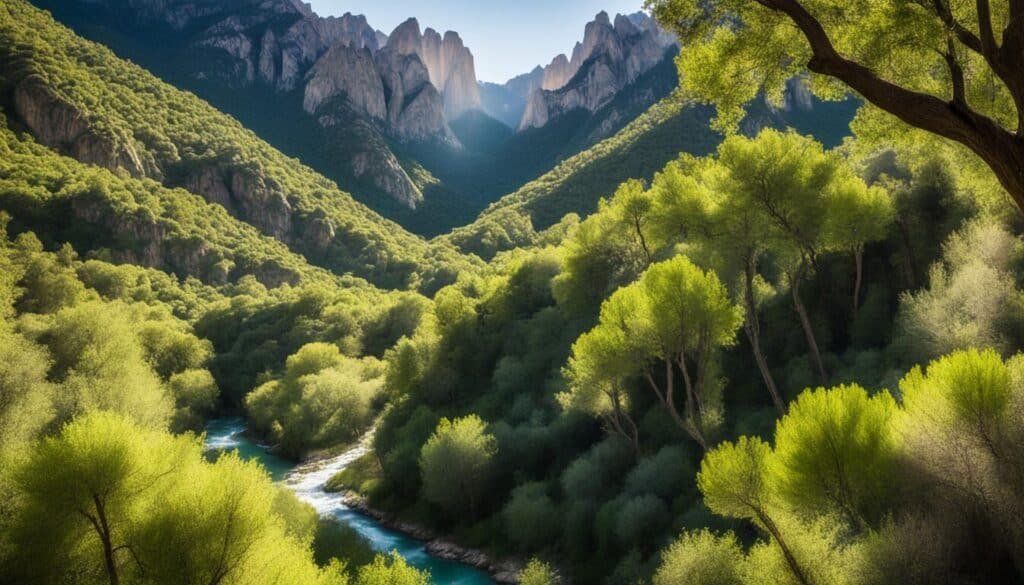
The Parque Natural de las Sierras de Cazorla, Segura y Las Villas is a magnificent protected area located in the province of Jaén, Andalusia. It is not only the largest protected area in Spain but also the second largest in Europe. This vast natural park spans an impressive 214,000 hectares, encompassing a diverse range of landscapes that include steep peaks, deep valleys, and lush forests.
The Parque Natural de las Sierras de Cazorla, Segura y Las Villas is a true biodiversity hotspot, home to a rich variety of flora and fauna. Its diverse ecosystems support a wide range of wildlife, including endangered species such as the Iberian ibex and the Spanish imperial eagle. The park also boasts a network of crystal-clear rivers and stunning waterfalls, offering visitors a chance to immerse themselves in the beauty of nature.
In addition to its natural wonders, the Parque Natural de las Sierras de Cazorla, Segura y Las Villas is also steeped in history and culture. Throughout the park, you’ll find ancient remains and archaeological sites that bear witness to the civilizations that once thrived in this region. From the Iberians to the Romans and Moors, these lands have been inhabited by various cultures throughout history.
«The Parque Natural de las Sierras de Cazorla, Segura y Las Villas is a true gem of Andalusia, offering a unique blend of natural beauty and cultural heritage.»
Whether you’re a nature enthusiast, a history buff, or simply seeking a serene escape, this remarkable park is a must-visit destination. With its breathtaking landscapes, abundant wildlife, and rich cultural heritage, the Parque Natural de las Sierras de Cazorla, Segura y Las Villas offers a truly unforgettable experience for all who venture within its borders.
Also Read : Experimenta la emoción del senderismo en diversos paisajes españoles
Conclusion
Spain’s parques nacionales y reservas naturales are not just ordinary parks, they are ecotourism destinations that offer a unique opportunity to explore and appreciate the country’s diverse natural landscapes. These protected areas, such as Parque Nacional del Teide and Parque Natural de la Sierra Helada, are a testament to Spain’s commitment to preserving its natural heritage and promoting sustainable travel.
With their designation as protected natural areas, these parks serve as wildlife sanctuaries and conservation areas, safeguarding the rich biodiversity that can be found within their boundaries. From the towering volcanic peaks to the untouched coastal beauty, these parks are biodiversity hotspots that harbor unique plant and animal species.
Visiting these parques nacionales y reservas naturales not only allows you to immerse yourself in nature, but also supports environmental preservation efforts. By choosing to explore these parks, you contribute to the conservation of these natural treasures and the sustainability of the surrounding communities.
Whether you’re a nature enthusiast, a wildlife lover, or simply seeking a peaceful retreat, Spain’s parques nacionales y reservas naturales offer an unforgettable experience. So plan your next adventure and discover the wonders of these environmental preservation parks.
FAQs
Q: ¿Qué es un parque nacional?
A: Un parque nacional es un área protegida que conserva ecosistemas representativos de la biodiversidad, declarada y gestionada con el fin de preservar su valor natural y cultural.
Q: ¿Cuántos parques nacionales hay en España?
A: En España, existen 16 parques nacionales que conforman la red de parques nacionales españoles.
Q: ¿Qué significa que un espacio natural sea declarado parque nacional?
A: Cuando se declara un espacio natural como parque nacional, se le otorga la máxima protección y se establecen medidas para garantizar su conservación a largo plazo.
Q: ¿Cuál es el parque nacional más antiguo de España?
A: El Parque Nacional de Covadonga, también conocido como Parque Nacional de los Picos de Europa, es el primer parque nacional declarado en España en 1918.
Q: ¿Qué organismos están involucrados en la gestión de los parques nacionales en España?
A: La gestión de los parques nacionales en España corre a cargo del Ministerio para la Transición Ecológica, en colaboración con las comunidades autónomas donde se ubican dichos espacios protegidos.
Q: ¿Qué parque nacional se encuentra en la Sierra de Guadarrama?
A: El Parque Nacional de la Sierra de Guadarrama es uno de los espacios protegidos más recientes de España, declarado en 2013.
Q: ¿Qué peculiaridad tiene el Parque Nacional de Garajonay en La Gomera?
A: El Parque Nacional de Garajonay en La Gomera es conocido por albergar uno de los bosques de laurisilva más importantes del mundo.
Q: ¿Cuántos parques nacionales y reservas naturales hay en España?
A: En España hay un total de 10 parques nacionales y reservas naturales.
Q: ¿Cuál es la red de parques nacionales en España?
A: La red de parques nacionales en España está compuesta por lugares como la Sierra de las Nieves, la Caldera de Taburiente, el Archipiélago de Cabrera, entre otros.
Q: ¿Cuáles son algunos ejemplos de parques nacionales en España?
A: Algunos ejemplos de parques nacionales en España son las Tablas de Daimiel, Cabañero, Aigüestortes, Islas Atlánticas, entre otros.
Q: ¿Qué es el parque nacional de Cabañeros?
A: El parque nacional de Cabañeros es una reserva natural en España que destaca por su flora y fauna variada.
Q: ¿Cuántos parques nacionales hay en España?
A: En España hay un total de 16 parques nacionales.
Q: ¿Qué se puede encontrar en las Islas Atlánticas de Galicia?
A: Las Islas Atlánticas de Galicia son un conjunto de islas con un ecosistema marítimo-terrestre único.
Q: ¿Cuál es la importancia de Aigüestortes i Estany de Sant Maurici?
A: Aigüestortes i Estany de Sant Maurici es un parque nacional de alta montaña con una gran biodiversidad.
Q: ¿Qué información se puede encontrar sobre los parques nacionales en España?
A: Encontrarás información sobre los parques nacionales de España, su flora, fauna y las actividades que se pueden realizar en ellos.
Source Links
- https://www.expansion.com/fueradeserie/viajes/2023/06/07/6475b990468aebd1738b4643.html
- https://www.traveler.es/articulos/parques-naturales-y-nacionales-mas-populares-de-espana
- https://www.elespanol.com/curiosidades/espana-pueblos/parques-naturales-bonitos-espana-espacios-protegidos-naturaleza-turismo-ecologico/573193334_0.amp.html
